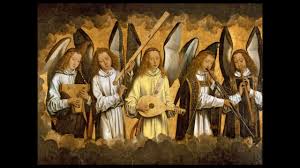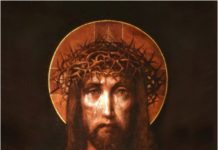Here is the Lamb of God who takes away the sin of the world! (Jn. 1:29). ⧾
This declaration made by John the Baptist and which we hear before the reception of Holy Communion at every Mass, is a succinct summary of the mission of the Messiah and the mission of the Church. As we noted last Sunday in our meditation, the mystery of the Church is the proclamation of this truth through the ages: Here is the Lamb of God who takes away the sin of the world! (Jn. 1:29). This proclamation engages all of us actively through the works of mercy and service, both spiritual and corporal, as we endeavour to alleviate the burden of sin; and passively or mysteriously as we share in the mission of the Son of God, the Lamb of God through the union of our own suffering with His. This union of our suffering with the Atoning Sacrifice of Our Lord made present in the Mass is a source of grace and of reparation; and this union is at once both active and passive, enabling us to find meaning and purpose in suffering, drawing us into the saving work of Christ through faith and obedience. When we come to understand this truth we see how every prayer, every sacrifice, every act of penance, every act of charity is at the service of the saving Mystery of Christ and nothing is without value or meaning. All of this is mystically brought about through the Mass and for this reason we rightly assert that the Mass is everything.
The Mass should draw us into this saving mystery principally through a profound spirit of adoration for the Sacrificial Presence of God Incarnate. Our conformity and devotion to the instructive and transformative grace of the sacred liturgy is the fullest form of participation in the sacred rites of the Church. As we commemorate the events and mysteries of Our Lord’s public life in the yearly cycle of the sacred liturgy, we consciously undertake a transformation in Christ in the awareness that this transformation is gradual and mystical, touching our hearts, our minds and emotions. This is how we correctly understand the term active participation at Mass.
The celebration of Holy Mass is both the school of faith and the feast of faith. The faith however, is nourished not only by doctrine; that is teaching or catechesis and preaching, but also by many other elements. If we consider the faith in the context of what are called the three great transcendentals – truth, goodness and beauty, we easily see that our growth in truth and goodness, essentially our growth in Christ’s likeness, is aided and made persuasive by the experience of beauty in the sacred rites of the Church. Our ability to apprehend and understand the truths of our faith and our willingness to practise the virtues and perform the works of mercy are aided by the experience of beauty in all its forms in the sacred liturgy. The path of beauty (via pulchritudinis) is a privileged path or way of coming to know the truth of God. This is not a question of aesthetics. Pope Benedict recognised the importance of this form of proclamation. Being struck and overcome by the beauty of Christ is a more real, more profound knowledge than mere rational deduction. Of course we must not underrate the importance of theological reflection…but to move from here to disdain or reject the impact produced by the response of the heart in the encounter with beauty as a true form of knowledge would impoverish us and dry up our faith and our theology. We must rediscover this form of knowledge; it is a pressing need of our time. This is especially pressing because generally speaking, the liturgy has suffered the evacuation of mystery and we have made it all about us and very little about God. Our celebration of Mass should make the mysteries more wondrous and the doctrines more luminous.
Historically, the Church has been the greatest patron of the arts in all their forms; and every art form from architecture to music has expressed the truth that we are contemplating: Here is the Lamb of God who takes away the sin of the world! (Jn. 1:29). At the Second Vatican Council the Fathers noted that the fine arts are righty classed among the noblest activities of man’s genius; this is especially true of religious art and of its highest manifestation, sacred art. Of their nature the arts are directed towards expressing in some way the infinite beauty of God …[and] to turning men’s minds devoutly towards God (Sacrosanctum Concilium, 122). In this same document the Fathers spoke also and most especially of sacred music as a treasure of inestimable value, greater even than that of any other art. The main reason for this pre-eminence is that, as a combination of sacred music and words, it forms a necessary or integral part of the solemn liturgy (112).
Here is the Lamb of God who takes away the sin of the world! (Jn. 1:29). This proclamation is timeless because all people are invited to call on the name of our Lord Jesus Christ, both their Lord and ours (1 Cor. 1:2). Our participation in making this proclamation and our sacrificial union with the Offering of the Lamb of God on the Altar are enhanced by the beauty of the liturgy. The validity of the liturgy is an objective reality but our participation has a subjective side. We join in Christ’s sacrifice to the extent that we are moved to do so, and the beauty of the liturgy – especially the music – has the capability to move us to deeper devotion, to a more fervent and firm resolve to love God. During the celebration of the sacred liturgy it is Christ our Saviour that we endeavour to hear and to see; to encounter, to love and to serve.
Ours is a humble country parish but we take pride in the beauty and decorum of this sacred edifice dedicated to the worship of God. Our humble circumstances however are not a barrier but rather an incentive to glorify God with even greater zeal. Our resources are limited but we recognise that it is especially in the atmosphere of the liturgy and amid the poems composed for it, in hymnis et canticis,[in hymns and canticles – that is to say, especially in the poetry and music of the liturgy] that the synthesis of all the arts is effected for in the worship of the Lamb immolated for the world’s salvation everything, all our resources attain their fullest meaning for we offer them to God in full recognition that they have come from Him(Dom Jean Leclercq, O.S.B., The Love of Learning and the Desire for God, p. 250-251). Truly, the Mass is everything.
The sacrality of every aspect of our worship, the vestments and vessels we use, the manner of our proclamation of God’s Word, our own personal dispositions, our music most especially; these should be imbued with a profound spirit of adoration. It is in the adoration of the Mystery of God Incarnate consummated at Mass in the Lamb of God that takes away the sin of the world that all that we are and all that we do is offered to the Father through the power and presence of the Holy Spirit. Let us ask Our Lord that through the intercession of Our Lady we may be granted the grace of an ever deeper understanding of the Holy Sacrifice of the Mass; and a more profound spirit of adoration in the awareness that the praise of God is our glory. ⧾










